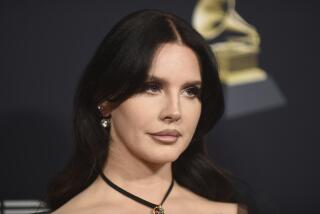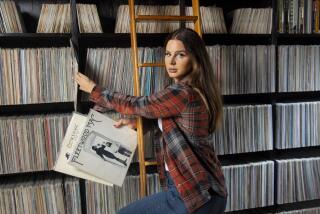Review: Lana Del Rey, Courtney Love are ships in the night at the Hollywood Bowl
On paper, a Lana Del Rey/Courtney Love tour sounds like one of the best pairings in recent pop music history. Both are lightning rods for the kind of vitriol reserved for female artists who step outside the rigid constraints of pop-star femininity â the elder stateswoman of sneering feminist invective and the millennial belle of the new nihilist uber-glam guard.
They have each been, in their own respective eras, high-profile scapegoats for the larger misogynistic issues that have plagued their industry for ⌠well, forever.
And each has aggressively confronted that prejudicial ire with polar opposite methods: Love by grotesquely mutilating unforgiving beauty and behavioral standards, and Del Rey by adopting disturbingly supercharged versions of those same mores and peppering them with provocative, unsavory trappings like hard drugs and glorified domestic abuse.
Del Rey and Love fit together like a blond feminist yin and yang, completing each other while also bringing balance to the Pop Culture Force. Plus, theyâre both wildly entertaining performers.
In practice, however, that idealized metaphor loses its sparkle. The two artists played back-to-back, nothing-but-the-hits sets at their Hollywood Bowl tour stop Monday night, two sets that mirrored each other but rarely, if ever, acknowledged the otherâs existence.
Loveâs 10-song set was a combatively casual affair featuring a bare-bones, no-frills stage setup. Tearing through Hole fan favorites, the frontwoman paced the stage barefoot in a slitted maxi dress, guitar draped grunge-style at thigh height, vacillating between raspy, slurred whispers and deep, serrated roars. Dare I say it? Her voice is more compelling now than it was at her band Holeâs â90s prime.
Whether she was moving through the set sober could be argued endlessly. It hardly matters; that uncertainty is her aesthetic, just like it is Del Reyâs â the deliberate performance of an affront to proper womanhood. Repeating the âDoll Partsâ refrain â âSome day, you will ache like I acheâ â Love seemed to add a new dimension to her decades-old anthems: the Courtney Love experience, much like the female experience, is unknowable to most.
Inscrutability, of course, is also Del Reyâs fortĂŠ. This was the big-haired songwriterâs second time performing in her beloved hometown in six months; her October appearance at the Hollywood Forever Cemetery was perhaps peak Del Rey â glamour nestled amid the morbid and melancholy of the famous dead â but the Bowl was far more suited to the grandiose production required to fully bring her fantasy world to life.
Embodying almost to a T the protagonist of Loveâs aforementioned âDoll Partsâ in a babydoll-style dress and signature heavy 1960s makeup, the singer used her ethereal head voice through songs like âColaâ and âShades of Coolâ as though it too were part of her intensely meta set design: Art-Deco-ish skyscraper constructions with film-set lights and vintage-film filters over the Bowlâs Jumbotron screens that rendered the stage a set made to look like another kind of set, an old-school Hollywood movie studio. Those screens were crucial â Lana Del Rey is not Lana Del Rey without cinematic framing.
Del Reyâs performances often look and sound as though sheâs doing karaoke to her own music, her voice wisping into thin air as the crowd took over.
In this instance, though, it worked for her. Pacing the stage as though performing a scene, through songs like âWest Coastâ (a crowd favorite, obviously) and âSummertime Sadness,â she paused between songs like a 1960s starlet taking a break from filming to sign autographs and collect various gifts from the audience. At one point, she greeted the crowd on an arc-shaped catwalk, stopping to take about 15 selfies with fans.
Her set was not without menace either. Del Rey had a rocky live beginning when she began touring her first major-label album, âBorn to Die.â But as sheâs grown more confident, sheâs begun actively toeing that line â between object and subject, demure and destructive â that critics have found so fascinating.
On âBorn to Die,â the most iconic of Del Reyâs many âcrazy girlâ songs, there was a slightly unhinged glint in her eye when she sang âyou like your girls insane.â During âBrooklyn Baby,â her delivery of âIf you donât get it/ Then forget it/ So I donât have to ⌠explain it,â her delivery of the profanity in that line came with a quick but sort of terrifying flash of bared teeth. Performing in front of a video of herself from a few years ago, she seemed so much older now: less navel-gazing hesitance, more confident in her vision for herself.
However, save matching Leonard Cohen covers and a brief acknowledgment of each otherâs existence on the tour (Loveâs salute to Del Rey, of course, referred to the latterâs famously profane âColaâ lyric comparing a body part and a certain soft drink), it was as though Del Rey and Love were playing distinct, one-woman bills.
They might as well have been playing on different nights, on different stages, in different corners of the city.
What was missing? A simple Cohen duet would have done the trick, if comparable fanfare and set design were out of the question. (Someone has to go first, of course, and Del Rey is a formidable performer capable of headlining that bill, but Love being her opener, with the skeletal environmental support mostly reserved for baby bands just happy for the opportunity, seemed injust in context, considering the inroads she made that gave precedent to Del Reyâs whole aesthetic.) While each act was executed as formidably as one could expect from either artist, the night was segmented in such a way that it lost a valuable opportunity to draw those parallels more cohesively, to truly demonstrate -- as it might have done with, say, a Pearl Jam/The Who bill â how powerful that kind of multigenerational tradition can be.
Follow @dynamofire and @PopHiss on Twitter for more music news and reviews.
More to Read
The biggest entertainment stories
Get our big stories about Hollywood, film, television, music, arts, culture and more right in your inbox as soon as they publish.
You may occasionally receive promotional content from the Los Angeles Times.










